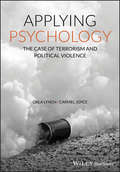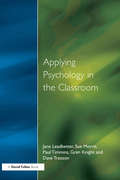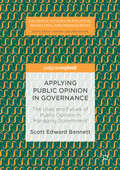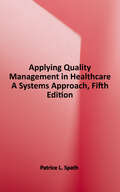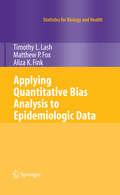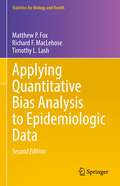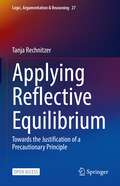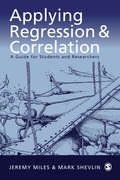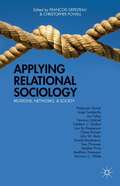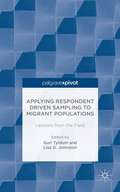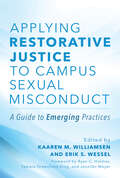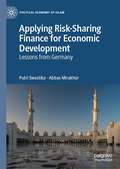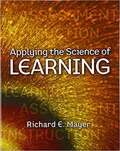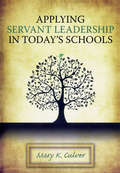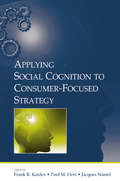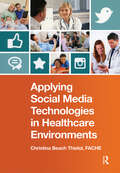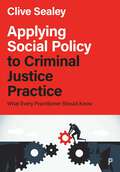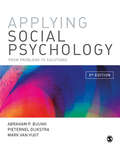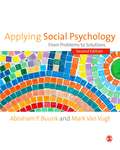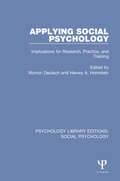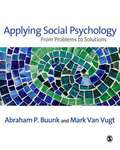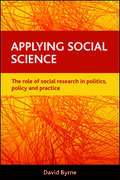- Table View
- List View
Applying Psychology: The Case of Terrorism and Political Violence
by Orla Lynch Carmel JoyceThis volume investigates the application of psychological theory to the case of terrorism and political violence. <p><p> This book offers a framework for approaching psychological research on terrorism that encourages an explicit orientation to the issues that have acted as road blocks to the potential for psychology as a discipline to meaningfully contribute to terrorism research. The framework encourages researchers to define the research parameters in clear concise terms, devoid of theoretical jargon and rooted in an understanding of real world social problems. Furthermore, researchers are encouraged to be explicit about the vantage point through which the problem is being viewed (i.e., is it a problem for participants themselves? For broader society, for policy-makers and other stakeholders?) and what the intended outcome of the research might be. <p> Furthermore, this volume aims to demonstrate how to apply existing psychological theory to terrorist related phenomenon. In doing so, researchers are asked to consider whether the research problem is psychological in nature and if so, what existing theories can help explain, if not alleviate the problem. As such, researchers in psychology are encouraged to dig deep, to tap into the wealth of knowledge available in psychology to understand terrorist related phenomenon as embedded within normal psychological processes, albeit manifesting in what can be considered exceptional situations and circumstances. <p> Applying Psychology: The Case of Terrorism and Political Violence will appeal to academics, students, and professionals interested in applied psychology, terrorism studies, sociology, international security, and international relations.
Applying Psychology in the Classroom
by Jane LeadbetterFirst Published in 1999. Routledge is an imprint of Taylor & Francis, an informa company.
Applying Public Opinion in Governance: The Uses and Future of Public Opinion in Managing Government (Palgrave Studies in Political Marketing and Management)
by Scott Edward BennettThis book explores how public opinion is used to design, monitor and evaluate government programmes in Australia, Canada, New Zealand, and the United Kingdom. Using information collected from the media and from international practitioners in the public opinion field, as well as interviews in each of the 4 countries, the author describes how views of public opinion and governance differ significantly between elites and the general public. Bennett argues that elites generally risk more by allowing the creation of new data, fearing that its analysis may become public and create communications and political problems of various kinds. The book finds evidence that recent conservative governments in several countries are changing their perspective on the use of public opinion, and that conventional public opinion studies are facing challenges from the availability of other kinds of information and new technologies. This book is a hugely valuable contribution to a hitherto little explored field and will appeal to academics and practitioners alike.
Applying Quality Management in Healthcare: A Systems Approach
by Patrice L. Spath“This book examines the real-world tools and techniques necessary for improving systems that affect patient care outcomes. The author explains how to explore and modify interconnected systems to make lasting changes that benefit the entire organization”--Provided by publisher.
Applying Quantitative Bias Analysis to Epidemiologic Data (Statistics for Biology and Health)
by Matthew P. Fox Timothy L. Lash Aliza K. FinkThis text provides the first-ever compilation of bias analysis methods for use with epidemiologic data. It guides the reader through the planning stages of bias analysis, including the design of validation studies and the collection of validity data from other sources. Three chapters present methods for corrections to address selection bias, uncontrolled confounding, and classification errors. Subsequent chapters extend these methods to multidimensional bias analysis, probabilistic bias analysis, and multiple bias analysis. The text concludes with a chapter on presentation and interpretation of bias analysis results. Although techniques for bias analysis have been available for decades, these methods are considered difficult to implement. This text not only gathers the methods into one cohesive and organized presentation, it also explains the methods in a consistent fashion and provides customizable spreadsheets to implement the solutions. By downloading the spreadsheets (available at links provided in the text), readers can follow the examples in the text and then modify the spreadsheet to complete their own bias analyses. Readers without experience using quantitative bias analysis will be able to design, implement, and understand bias analyses that address the major threats to the validity of epidemiologic research. More experienced analysts will value the compilation of bias analysis methods and links to software tools that facilitate their projects.
Applying Quantitative Bias Analysis to Epidemiologic Data (Statistics for Biology and Health)
by Matthew P. Fox Richard F. MacLehose Timothy L. LashThis textbook and guide focuses on methodologies for bias analysis in epidemiology and public health, not only providing updates to the first edition but also further developing methods and adding new advanced methods. As computational power available to analysts has improved and epidemiologic problems have become more advanced, missing data, Bayes, and empirical methods have become more commonly used. This new edition features updated examples throughout and adds coverage addressing: Measurement error pertaining to continuous and polytomous variables Methods surrounding person-time (rate) data Bias analysis using missing data, empirical (likelihood), and Bayes methods A unique feature of this revision is its section on best practices for implementing, presenting, and interpreting bias analyses. Pedagogically, the text guides students and professionals through the planning stages of bias analysis, including the design of validation studies and the collection of validity data from other sources. Three chapters present methods for corrections to address selection bias, uncontrolled confounding, and measurement errors, and subsequent sections extend these methods to probabilistic bias analysis, missing data methods, likelihood-based approaches, Bayesian methods, and best practices.
Applying Rawls in the Twenty-First Century
by Martin D. CarcieriJohn Rawls is the most influential political thinker of the twentieth century. Most of the scholarly literature on Rawls defends, critiques, or elaborates on some aspect of his theory. These writings are often valuable, yet this book goes beyond them. Like a few scholars, rather than debating whether and how Rawls got things right or wrong, Martin Carcieri take his well-defended principles of justice - especially the equal liberty, fair equality of opportunity, and difference principles atthe core of his theory - as given and apply them to aspects of four major, enduring, concrete domestic policy, ethical, and constitutional issues. These applications yield counter-intuitive implications that will challenge the ideological left and right alike, contributing to our understanding both of Rawls and of these issues. At the core, this book deepens our understanding of these issues and points the way toward rational, just policy reform.
Applying Reflective Equilibrium: Towards the Justification of a Precautionary Principle (Logic, Argumentation & Reasoning #27)
by Tanja RechnitzerThis open access book provides the first explicit case study for an application of the method of reflective equilibrium (RE), using it to develop and defend a precautionary principle. It thereby makes an important and original contribution to questions of philosophical method and methodology. The book shows step-by-step how RE is applied, and develops a methodological framework which will be useful for everyone who wishes to use reflective equilibrium. With respect to precautionary principles, the book demonstrates how a rights-based precautionary principle can be constructed and defended. The case study succeeds in demonstrating that RE can be successfully applied and puts real constraints on the justification process. This is all the more remarkable as the case study was designed as an open-ended process, without presupposing any specific results. This book will be highly relevant both to people interested in philosophical methodology and epistemology, as well as to researchers who are interested in using philosophical methods and tools and applying them to practical problems.
Applying Regression and Correlation: A Guide for Students and Researchers
by Dr Jeremy Miles Dr Mark ShevlinThis book takes a fresh look at applying regression analysis in the behavioural sciences by introducing the reader to regression analysis through a simple model-building approach. The authors start with the basics and begin by re-visiting the mean, and the standard deviation, with which most readers will already be familiar, and show that they can be thought of a least squares model. The book then shows that this least squares model is actually a special case of a regression analysis and can be extended to deal with first one, and then more than one independent variable. Extending the model from the mean to a regression analysis provides a powerful, but simple, way of thinking about what students believe are the more complex aspects of regression analysis. The authors gradually extend the model to include aspects of regression analysis such as non-linear regression, logistic regression, and moderator and mediator analysis. These approaches are often presented in terms that are too mathematical for non-statistically inclined students to deal with. Throughout the book maintains a conceptual, non-mathematical focus. Most equations are placed in an appendix, where a detailed explanation is given, to avoid disrupting the flow of the main text. This book will be indispensable for anyone using regression and correlation from undergraduates doing projects to postgraduate and researchers.
Applying Relational Sociology
by Fran�ois D�pelteau Christopher PowellEdited by Fran#65533;ois Depelteau and Christopher Powell, this volume and its companion, Conceptualizing Relational Sociology: Ontological and Theoretical Issues, addresses fundamental questions about what relational sociology is and how it works.
Applying Respondent Driven Sampling to Migrant Populations: Lessons from the Field
by Lisa G. Johnston Guri TyldumThis book gives a thorough introduction to the theoretical and practical aspects of planning, conducting and analysing data from Respondent Driven Sampling surveys, drawing on the experiences of experts in the field as well as pioneers that have applied Respondent Driven Sampling methodology to migrant populations.
Applying Restorative Justice to Campus Sexual Misconduct: A Guide to Emerging Practices
by Kaaren M. Williamsen Erik S. WesselWhile sexual misconduct on our college and university campuses, both public and private, is dismayingly widespread, it continues to be significantly underreported because most victims perceive that judicial recourse, with its legalistic adversarial approach, fails to address--in a healing way--the harms done to them. Fewer still file formal complaints, many for fear that they may lose agency and that the process may rekindle the trauma of their experience.Recognizing the reality that supermajority of sexual harms in higher education are rarely addressed through established legalistic practices, this book offers a range of alternative approaches based on restorative justice.Starting from the premise “What if we started with the goal of healing in mind”, this book opens with an overview of common restorative practices and accounts of application and lessons learned by practitioners who have implemented a range of restorative justice and alternative-based approaches. Subsequent chapters cover procedural elements, recommendations around documentation. and interventions for individuals who have caused harm through sexual and gender-based misconduct.The book addresses facilitation; the need to pay attention to self, people, and systems, identities, and power dynamics; the considerations for working restoratively with both complainants and respondents; offers cases and adaptable examples of resolution; and concludes with reflections on institutional implementation from the perspectives of administrators, facilitators, and a student survivor.Recognizing there will always be a need for a formal investigatory approach to cases of sexual misconduct, the book offers a wide range of alternative options that empower those who are most directly affected to make the call for themselves. In doing so, it may increase reporting and, furthermore, in offering a healing justice that addresses individual and community needs, may work to reduce sexual misconduct on campus.
Applying Risk-Sharing Finance for Economic Development: Lessons from Germany (Political Economy of Islam)
by Putri Swastika Abbas MirakhorThis book examines the application of risk-sharing finance as a national economic policy in history and how it stimulated economic recovery during a short period in Germany between 1933 and 1935. Economic history indicates that risk-sharing instruments have promoted socio-economic development in many parts of the world while risk-shifting methods have imposed huge socio-economic costs on many nations, leading to debt slavery on individual members. This book highlights lessons to be learned from history and argues that risk-sharing is a powerful tool for generating rapid economic recovery and resumption of growth.
Applying The Science Of Learning
by Richard MayerA concrete guide to the science of learning, instruction, and assessment written in a friendly tone and presented in a dynamic format. The underlying premise of Applying the Science of Learning is that educators can better help students learn if they understand the processes through which student learning takes place. In this clear and concise first edition text, educational psychology scholar Richard Mayer teaches readers how to apply the science of learning through understanding the reciprocal relationships between learning, instruction, and assessment. Utilizing the significant advances in scientific learning research over the last 25 years, this introductory text identifies the features of science of learning that are most relevant to education, explores the possible prescriptions of these findings for instructional methods, and highlights the essentials of evaluating instructional effectiveness through assessment. Applying the Science of Learning is also presented in an easy-to-read modular design and with a conversational tone ― making it particularly student-friendly, whether it is being used as a supplement to a core textbook or as a standalone course text.
Applying Servant Leadership in Today's Schools
by Mary CulverThis book illustrates how the ideal of servant leadership can be applied in your school today. With real-life scenarios, discussions, and self assessments, this book gives practical suggestions to help you develop into a caring and effective servant leader.
Applying Social Cognition to Consumer-Focused Strategy (Advertising and Consumer Psychology Series)
by Frank R. Kardes Paul M. Herr Jacques NantelApplying Social Cognition to Consumer-Focused Strategy, a book in the Advertising and Consumer Psychology series sponsored by the Society for Consumer Psychology, focuses on the most important recent developments at the interface of social cognition and marketing, and develops integrative theoretical frameworks with rich practical implications. More specifically, the chapters offer a novel and thought-provoking perspective on consumer-focused strategy--or the effects of marketing stimuli and activities on an integrated system of consumer processes and responses.Divided into four parts, this book:*offers new perspectives on consumer information processing, selective or one sided information processing, and attribution theory;*discusses how asking questions in focus groups, surveys, and experiments leads consumers to create opinions that would not have occurred to them otherwise;*advances a new approach for modeling uncertainty and a new framework for thinking about uncertainty;*summarizes recent developments concerning the Implicit Association Test and their implications for branding strategy;*develops a new approach for analyzing the effects of intention on behavior and unplanned purchase behaviors;*discusses the devaluation effect and shows both how implementation intentions can be used to increase new product consumption and also how promotion versus prevention regulatory focus influences consumer preferences; and*focuses on consumer information processing and persuasion.The text is intended for advanced graduate students, academics, and practitioners who embrace cutting-edge paradigms and methodologies in social-cognitive consumer research.
Applying Social Media Technologies in Healthcare Environments (HIMSS Book Series)
by Christina Beach ThielstApplying Social Media Technologies in Healthcare Environments provides an indispensable overview of successful use of the latest innovations in the healthcare provider-patient relationship. As professionals realize that success in the business of healthcare requires incorporation of the tools of social media into all aspects of their worlds and recognize the value offered by the numerous media channels, this compendium of case studies from various voices in the field-caregivers, administrators, marketers, patients, lawyers, clinicians, and healthcare information specialists-will serve as a valuable resource for novices as well as experienced communicators. Written by experienced players in the healthcare social media space and edited with the eye of an administrator, chapters provide insight into the motivation, planning, execution, and evaluation of a range of innovative social media activities. Complete with checklists, tips, and screenshots that demonstrate proven application of various social channels in a range of situations, this will be a valuable tool to maximize opportunities in meeting the challenges of new healthcare demands.
Applying Social Policy to Criminal Justice Practice: What Every Practitioner Should Know
by Clive SealeyThis book aims to make clear the interconnections between social policy and criminal justice practice, bringing together key social policy concepts within a framework for reducing reoffending rates. The book focuses on the key social policy issues of employment, health and mental health, low income and poverty, housing and family. It shows how understanding and treating these as issues interconnected to criminal justice outcomes can and does lead to improvements in criminal justice practice. This book enables students and criminal justice practitioners to understand how a social policy focus can better inform practice with those involved in the criminal justice system. It features: • a 10 point summary of key points for learning; • chapter heading questions to support independent learning; • tables and graphs to illustrate the text.
Applying Social Psychology: From Problems to Solutions
by Abraham P Buunk Pieternel Dijkstra Mark Van VugtAre you hoping to apply what you’ve learnt in your studies to real world problems? Are you wondering how your work might make a difference? This book offers a model to ensure that your application of theoretical social psychology stands the best chance of success. Follow the PATHS model help you develop your intervention, test it, action it, and evaluate it. Each chapter focuses on a step in the model and is built around a real world example. Full of practical advice, each chapter also has an assignment to help you think through your plans and check you’ve covered all bases. Essential reading for anyone applying social psychology to real world practices and events.
Applying Social Psychology: From Problems to Solutions
by Abraham P Buunk Pieternel Dijkstra Mark Van VugtAre you hoping to apply what you’ve learnt in your studies to real world problems? Are you wondering how your work might make a difference? This book offers a model to ensure that your application of theoretical social psychology stands the best chance of success. Follow the PATHS model help you develop your intervention, test it, action it, and evaluate it. Each chapter focuses on a step in the model and is built around a real world example. Full of practical advice, each chapter also has an assignment to help you think through your plans and check you’ve covered all bases. Essential reading for anyone applying social psychology to real world practices and events.
Applying Social Psychology: From Problems to Solutions (SAGE Social Psychology Program)
by Abraham P Buunk Dr Mark Van VugtThe Second Edition of this best selling textbook continues to offer a simple, systematic, step-by-step guide to doing applied psychology.<P> Using the authors' own PATH model, the text presents a new methodology for applying primarily social psychological theory to a wide range of social problems.<P> With real-world case studies, end-of-chapter exercises and interviews with leading social psychologists, Applying Social Psychology guides students to define a problem, conduct a theory-based analysis, develop an explanatory model, set up and execute a research project to test the model, and develop an intervention.<P> Written in the same engaging and accessible way, this Second Edition offers:<P> * A new appendix with examples of PATH model applications<P> * An extended glossary<P> * Case studies from organizational, health, and environmental psychology<P> * Recent applied social psychology research<P> * More focus on applied evolutionary psychology <P> Social network analysis and social media as research tools.<P> This is a highly practical text, which can be used by introductory and advanced level students who want to learn how to analyze practical problems and develop solutions based upon social psychological theory and research.<P>
Applying Social Psychology: Implications for Research, Practice, and Training (Psychology Library Editions: Social Psychology)
by Morton Deutsch Harvey HornsteinOriginally published in 1975, these contributions surveyed the range of social intervention technology available to psychologists at the time, but they are more than a simple cataloguing of technology. The stress is on articulating certain metatheoretical assumptions that underlie different strategies of social intervention. For example, assumptions about the personal agency, the nature of social systems, and levels and forms of interpersonal influences are all examined. The implications for the training of psychologists are developed, and specific attention is given to the identity crisis in social psychology precipitated by existing pressures and potentials for change at the time.
Applying Social Psychology
by Mark Van Vugt Abraham P. Buunk`I think this is a wonderful book. The social psychological theories are exceptionally well presented for practical use. Anyone studying social psychology will find this book extremely relevant and accessible' - Gerjo Kok, Professor of Applied Psychology, Department of Work and Social Psychology, Maastricht University `This is a highly readable book dealing with an exciting topic, applied social psychology, which is at the heart of many urgent problems of the new millennium. It is well suited for curing the disease of those who still believe there is an opposition between fundamental and applied research, between theories and practice. The major asset of this volume lies in the originality and strength of the PATH concept -- from problem definition, over analysis, and test, to helping. I like the idea to implement and institutionalize this framework in teaching and in education' - Klaus Fiedler, University of Heidelberg Introducing a new methodological approach for doing applied psychology, the PATH model, this book offers a simple, systematic, step-by-step, easy-to-use methodology for applying primarily social psychological theory to a wide range of social problems, from tackling crime and prejudice to fostering environmental conservation and team performance. It helps and guides students to define a problem, conduct a theory-based analysis, develop an explanatory model, set up and execute a research project to test the model, and develop an intervention. Applying Social Psychology is a highly practical text, which can be used by introductory and advanced level students who want to learn how to analyze practical problems and develop solutions for these problems based upon social psychological theory and research. Written in an engaging and accessible way, this book offers: 1. A new methodological model put forward by the authors (PATH model); 2. Real world case studies; 3. End of chapter exercises; 4. Interviews with leading social psychologists; 5. Glossary of key theories and concepts in social psychology; 6. Recommended further reading.
Applying social science: The role of social research in politics, policy and practice
by David ByrneIn complex contemporary societies social science has become increasingly interwoven into the whole fabric of governance. At the same time there is an increasing recognition that attempts to understand the social world which seek to mimic the linear approaches of the conventional 'hard sciences' are mostly useless given the complex systems character of society in all its aspects. This book draws on a synthesis of critical realism and complexity theory to examine how social science is applied now and how it might be applied in the future in relation to social transformation in a time of crisis. A central argument is that there is no such thing as a 'pure' science of the social and that a recognition of the inevitability of application imposes obligations on social scientists wherever they work which challenge the passivity of most in the face of inequality and injustice.
Applying Standards-Based Constructivism: Secondary
by Paul Vermette Pat Flynn Don MesibovThis book provides teachers with practical ways of constructing lessons that will engage students and help them develop personal responsibility for their own learning. State learning standards and related core curricula require students to demonstrate what they know and understand. Students cannot learn to demonstrate their understanding if they sit passively. The authors call for constructivist practices which recognize the important role played by standards and student accountability, and which also acknowledge the practical need for lecture in an appropriate context. This book also shows the links between constructivism and differentiated instruction and other approaches to teaching and learning.
